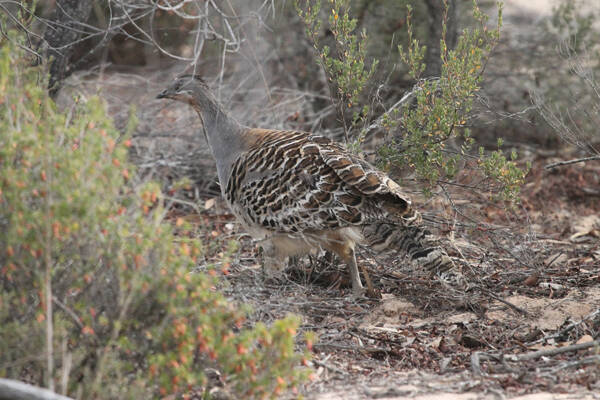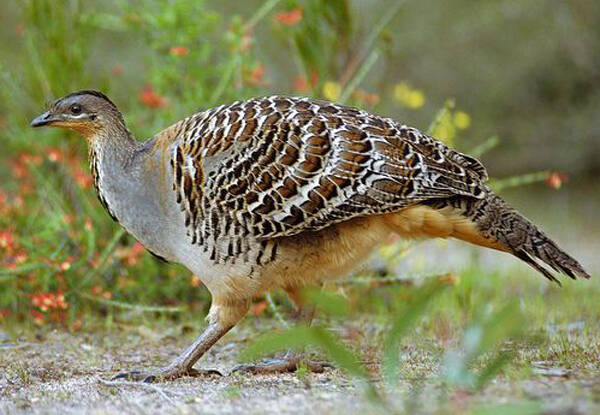Malleefowl
IUCN
LCBasic Information
Scientific classification
- name:Malleefowl
- Scientific Name:Malleefowl,Leipoa ocellata
- Outline:Landfowl
- Family:Pheasant P.family P.Genus
Vital signs
- length:60-65cm
- Weight:1.5-2kg
- lifetime:No textual research information is available
Feature
The foreign name "megapodes" means "big feet"
Distribution and Habitat
Eye megapods were once widespread in Australia, but have declined by more than 50%. It has not been recorded in the Northern Territory for decades and is thought to be extinct there. Most pheasants live in scattered areas of South Australia, New South Wales and Victoria.
It lives in the arid areas of the Australian outback, mainly in shrubland, dwarf eucalyptus forests, heather and coral islands scattered with sparse trees. It lives in lowlands and mountain rainforests, but also in modified habitats. It reaches an altitude of 1065 meters. They nest on vast sandy, volcanic soils or coastal beaches, including beaches, lakes and river banks.
Appearance
The pheasant is 60-65 cm long and weighs 1.5-2 kg. It is a large ground dwelling bird, one of 22 species in the Tragopan family. They are called "megapodes," meaning "big feet." Their name originates from the type of mallee eucalypts that is the most related habitat. Adult males and females are identical in appearance, with a predominantly grayish-brown coloration and wide black markings on the throat. The upper body has black, white and chestnut feathers, and the legs and claws are gray. The juvenile is grayish brown in plumage and does not have cream markings on its body. The birds make purring and boisterous sounds, with the males calling louder.
Details
Malleefowl (Leipoa ocellata), no subspecies.

The pheasant is very timid and cautious, and will run away or hide in a tree when in danger. Although they are active, they are immediately stationary when disturbed, using their body's ability to camouflage to avoid. They also have a variety of ways to escape predators. Temperament is withdrawn, often alone activity, even in breeding season is rarely paired activity. Weak in flight, but very good at running. Likes to make loud, high-frequency chirps. Food is plant flowers, seeds, fruits, etc., mainly eat fruits, seeds, ants, termites, beetles and other small invertebrates.
Every year when the breeding season enters, the male eye megacanth pheasant appears busy in the jungle. They kept digging in the ground with their big claws, and finally dug out a big pit, 1 meter deep, and the diameter of the pit was 4.5 meters. Then, they gather a lot of dry leaves, hay, etc. around them and pile them up in the big pit. After the pit is filled, they continue to pile up until they are 1.2 meters above the ground and the diameter of the pile is 3-4 meters. After the pile of leaves is built, the next step is to wait for the rain. After the leaves are soaked by the rain, the pheasant begins to pile up sand again. The sand layer can be up to 0.5 m thick. The eggs are incubated by the heat generated by the rotting fermentation of leaves in the pile of leaves, and can even be incubated by the heat of the sun or the heat generated by volcanic activity.

After the initial completion of the "great project", the leaves begin to rot, and when the heat generated by the fermentation brings the temperature inside the pile to 33.3 ° C, it builds an egg chamber on the top of the pile. Until these steps are complete, the female is allowed to climb to the top of the large pile of leaves and lay an egg in the egg chamber. After laying her eggs, the female must leave immediately and the male will place the eggs. Every two or three days, the female lays an egg. A total of 35 can be produced. Strangely, male birds always lay their eggs upright with the pointed ends facing down, unlike the way other birds lay their eggs flat. All insuka birds have an active air chamber within their eggs, which moves above the embryo if their eggs are laid flat. As it develops, the gas chamber gets larger, pressuring the embryo. For this reason, camp birds always place their eggs upright in the egg chamber. Thus, as in other birds, the air chamber is always at the blunt end of the egg.
As the leaves ferment, heat builds up and the egg chamber heats up. If the temperature tends to get too high, the pheasant will quickly peel away the sand to dissipate the heat. Gradually, the temperature in the egg chamber gets colder, and the male pheasant hurriedly piles the sand on top of the leaves. In this way, the male eye house pheasant picked up the sand again and again, and worked day and night, constantly adjusting the temperature of the pile of leaves, so that the temperature of the egg chamber at the top of the pile was always 33.3℃. Observation records show that it takes four months to accumulate a single pile of leaves, adjust the room temperature, and incubate the pheasant, and another seven months.
Every day, the male pheasant checks the temperature of the egg chamber. During this check, he quickly digs a hole in the sand layer and burrows his head and upper body into the hole. If the temperature changes slightly, it takes immediate action. Therefore, it is speculated that the neck skin and other parts of the male pheasant are very sensitive heat detectors. After seven weeks of incubation, the chick begins to break out of its shell. Not only do these chicks have to peck through the eggshell, but they also have to burrow from the egg chamber and only see the strange world outside the egg chamber hours after birth. Independent life begins, and the chicks no longer need both parents, for soon after they are born, they can fly awkwardly low, and sometimes even fly to rest on low branches. The chicks of the male eye tragopan mature in a year and can build their own large leaf piles.
The distribution range of the pheasant is narrow and limited, and it is believed that there is a moderate decline in the population, which is due to habitat loss, rainfall reduction, tourism impact, and road development, resulting in changes in the living environment. It has been classified as a vulnerable species.
Listed on the International Union for Conservation of Nature (IUCN) 2016 Red List of Threatened Species ver 3.1 - Vulnerable (VU).
Protect wild animals and eliminate wild meat.
Maintaining ecological balance is everyone's responsibility!








